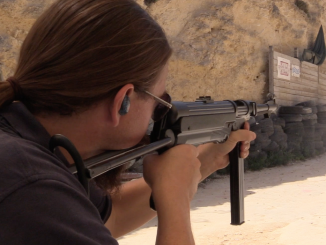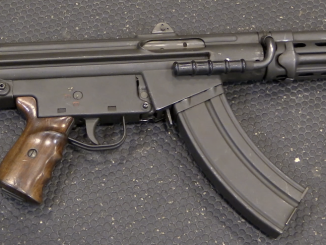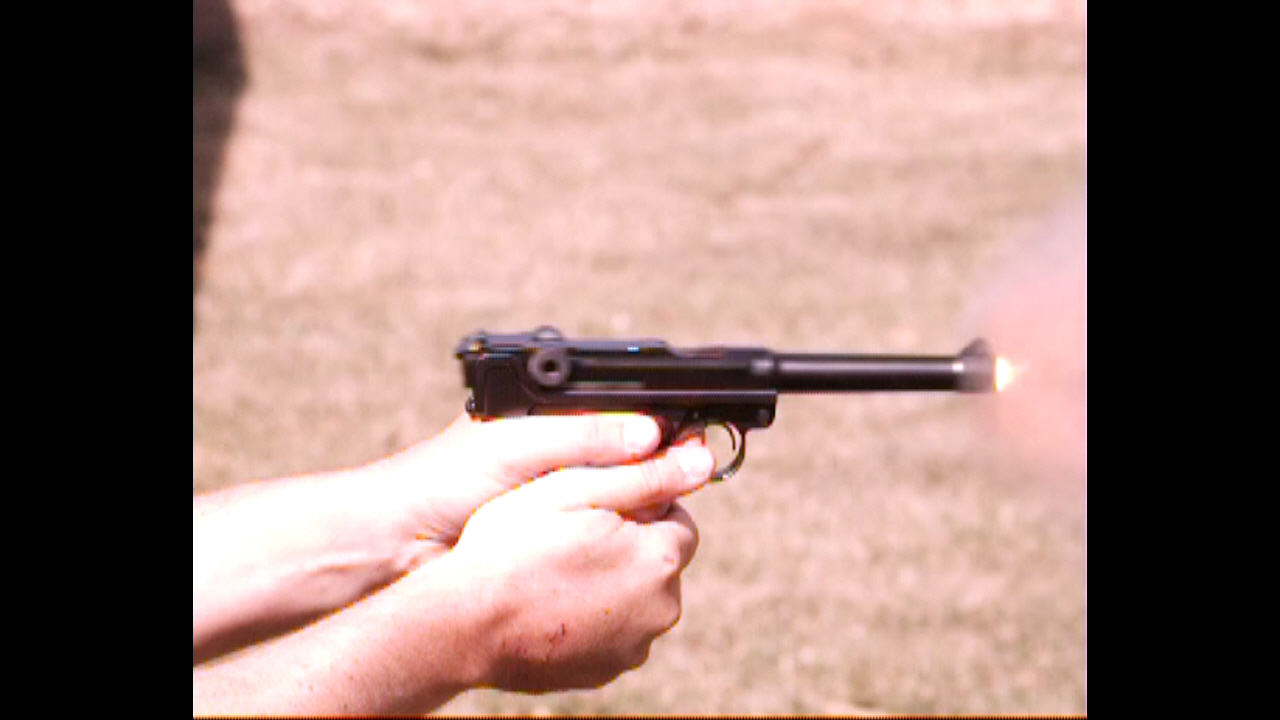One of the items at RIA in this upcoming Premier Auction is a Nazi belt-buckle pistol. There is a fair amount of debate as to whether these are authentic WWII German artifacts, as opposed to post-war creations to feed the market for Nazi memorabilia. Authentic or not, they are a very neat mechanism to take a look at…
Related Articles

Semiauto Rifles
Sport Systeme Dittrich Semiauto BD-38 (MP-38)
Sport Systeme Dittrich in Germany is a manufacturer of a remarkably wide range of reproduction German World War Two small arms (including the FG42, StG-44, G43, MP-3008, MP-35, and VG1-5 as well as the MP-38). […]

Select-fire Rifles
HK-32 Prototype in 7.62x39mm
Among the large family of roller-delayed rifles produced by Heckler & Koch, one of the rarest and least known is the HK32. This was the select-fire shoulder rifle chambered in 7.62x39mm. These rifles appeared in […]

Semiauto pistol
KrauseWerke .45ACP Luger at RIA
The story of the .45ACP Lugers is a bit complex, and widely misunderstood. What most people believe is that two such guns were made for US military testing, one was lost, and the other is […]

You say it’s a 22 rimfire, RIA lists it as 32 ACP centerfire.
I just called RIA and asked them to double check the caliber. I could’ve sworn it was .22, but I could be wrong. OTOH, they do occasionally have mistakes in the catalogs. I’ll let you know when I hear back from them.
According to Winant (Firearms Curiosa), the one in the Gov. Gordon Persons collection was a four-shot .32ACP. There was also a two-shot .32, which IIRC was in the Aberdeen collection. Both were documented as having been “acquired” in Germany.
I doubt they were ever an “issue” weapon. In fact, I suspect they may have been prototypes. So i wouldn’t rule out one in .22, or .25 ACP for that matter.
I do remember one of my uncles who served in ETO (U.S. 2nd Army) stating that in the closing days of the war, they were made aware of the existence of such “escape devices” that might be worn by high-ranking Nazis, probably SS.
After that, any German officer casually resting his hand on his belt buckle while surrendering was risking a bullet.
cheers
eon
Himmler was probably thinking of escaping by then, either trying to start a post Hitler regime as Adolf clearly wouldn’t be surrendering or just general running off to Argentina etc.
There was the U.S glove gun, as an equivalent idea in regards a pretending to surrender weapon sort of thing.
They might have thought about something similar…
Pdb;
Nope. The Glove Gun being a “spy device” is one of those recurring myths.
The fact that they were made by the Naval Gun Factory, that they were mounted on a heavy work glove, and that they were mostly left-hand gloves, betrays their true purpose. They were intended for heavy equipment operators of the Naval Construction Battalions, the SeaBees, during the island campaign in the PTO.
It was found that during raids and wave attacks, Japanese soldiers had adopted the tactic of climbing on a bulldozer, etc., and grappling with the driver, usually with a bayonet. They consistently attacked from right and behind to grab the driver by his right arm and keep him from reaching a pistol or Thompson SMG.
The Glove Gun, worn on the left hand, was to allow the driver to shoot his attacker by simply punching him, preferably in the face. Since SeaBees normally wore work gloves anyway, for obvious reasons, the glove-mounted, plunger-fire gun wasn’t considered a handicap to “carry”.
BTW, the mechanism was basically that of a “coyote trap gun”, modified to fire when the actuating rod was pushed back, rather than being pulled forward, as usual.
IIRC, instead of being cocked ahead of time like the regular trap gun searage, the plunger pushed the striker back against the spring until it reached full retraction, at which point the striker seared off and fired the piece. In effect, a “double-action-only” (DAO) searage. This was the only “safety” on it, apparently.
I don’t know how many were actually issued. One of my uncles commanded a SeaBee unit from Guadalcanal to Okinawa, and he never mentioned it, but then I never thought to ask him, either.
His preferred solution was either his M1917 .45 revolver or his Model 97 Winchester “trench shotgun”. Plus a Bowie knife for “up close and personal” work.
cheers
eon
Ha ha, oh right…
eon’s glove gun revelation makes perfect sense, though I suspect that said purpose might have gotten garbled by the time the weapons were produced and issued. I recall reading somewhere about a PT Boat crew having been issued one, and assuming that it was intended for some sort of “false surrender” situation.
I wonder if Quentin Tarantino would buy that?
What retains the cartridges in the chambers when it’s folded? Seems like they’d slide out.
The shoulder or the side wall where the barrels to prop up and hooked as locked in ready to fire position, retains the cartridges at folded mode.
There are various pages on the net for this rarity, and .32″ ones seems two barreled while .22″‘s having four. All states that designer of this gun was Louis Marquis Jr, a German inventor and engineer and this is an improvement of his patented belt buckle pistol that The US Patent Number of which is 2046523, published july 1936. The subject matter of this patent is a quite different rotating magazine type, however.
The muzzles look wider than .22 but the firing pins are surely rimfire they strike from the side via the cut outs in the barrels don’t they…
I’m not sure if they are real or not, they look well made, of decent design etc… But someone other than Ze Nazi state could have made them, both reasons for making them are plausible, to sell or as an escape weapon, possibly given the date a escape from defeated Nazi Germany idea even.
Many years back, a dealer in New Orleans had a 4 bbl. .32 ACP version for sale. Unlike the others I’ve seen referenced, this one was highly polished and kept in a small glass presentation case. He wanted $6500 for that one, and this was in the late ’80s. The degree of finish would suggest something that only a high-ranking officer would wear, but looking at the size and thickness of the buckle, the dimensions would definitely give away its true purpose. Had I not been a broke student back then, it would probably be sitting in my safe right now.
They are cool, but their authenticity is somewhat dubious for that kind of cash in my opinion.
An escape gun, would have been better as a single shot .22Lr pen gun thing which you pull out of a buckle to use as Liberator… For maximum concealment, probably.
And if your surrendering, the glove gun is a better design, hands up type thing.
Maybe they toyed with the idea regardless, but I am skeptical.
How to categorize this ‘weapon’? I’d suggest term, as equivalent to firearm – “fire-belly”…. or ever “fire-bellum”. That would fit.
I can suggest ‘very last ditch weapon’.
It has recesses for rimmed cartridges on the breech of each barrel I think, hmmm… It looks, authentic’ish well made… It looks German.
Maybe it wasn’t an “escape” pistol, could have been a novelty idea… Wedding present from Himmler suggestion for, those pure of blood or whatnot. They were fond of fancy daggers, rings, and various trinkets the S.S… Also in the early days the Nazis had a lot of street fights, might be nostalgic for then, but made later “this would have been handy etc” or as a personal defense weapon, Allegmin… Whatever S.S, black uniform ones, in the period of mopping up the opposition after taking power etc.
Mind you it might be German, but not Nazi, alternatively it could be from anywhere… The buckles embellishment isn’t typical of other S.S or other military buckles, just having a open winged eagle over a ringed Swastika. Maybe that was a more political symbol, diplomatic core, politicians, who knows… Has anyone ever tried fitting it to the issue belts of various types of the period, does it fit?
If not what type of fitting is it, Americans, well cowboys have fancy belt buckles, if it fits a typical cowboy belt that might provide a clue to it’s origin.
The eagle-over-hakenkreuz emblem, with no other elements, was pretty much an SS “proprietary” insignia, i.e., not used by Wehrmacht, etc.
The usual SS “eagle” has the longest feathers at the middle of each wing, not the top. But specific eagle emblems, such as those for Allgemeine SS, SA, etc., do have the longest feathers at the top. This eagle was also used on the hilt of the SS “Holbein” dagger.
This would tend to confirm that this gadget, if authentic, was intended for the Schutzstaffel. Who seem to have had a mania for weird and esoteric things in general. See “Ahnenerbe”, and keep in mind that they pursued all sorts of expensive and bizarre “research” right through the war.
cheers
eon
It isn’t typical, looking at the other ones.
The eagles sit on large Swastikas, within a further embellished circle.
The Anhalb… Something in German, what you mean eon are the arcolgists… Something in English, the baddies Indiana Jones is up against right 🙂
I used to be based in a former Panzer barracks and rumour was there was a S.S shrine under the road between HQ and the officers mess there was three doors which went into tiny rooms with what was described as a carved altar of snakes and swastikas, don’t know if it was true.
“The eagle-over-hakenkreuz emblem, with no other elements, was pretty much an SS “proprietary” insignia, i.e., not used by Wehrmacht, etc.”
https://en.wikipedia.org/wiki/Coat_of_arms_of_Germany#Nazi_Germany
The one in the middle (Reichsadler, or better known as Wehrmachstadler) was used extensively by the Wehrmacht (in fact they used it on buckles together with the Prussian motto “Gott mit uns”). However, as we can clearly see the eagle on this buckle looks in the other direction which makes it the emblem of the NSDAP.
Well it doesn’t appear to have been Hitlers belt buckle, looking at his numerous portraits, pity that would have been some provenance.
A doctor evil type dismissive device, the trapdoor chair etc.
“Ya das ist gud Herr Churchill, ve vill surrender immediately, I will just lean back a moment… Ha hah! Take zis, and zis! Schweinhunt piggy dog!”
They’re fakes. The biggest clue that they’re fakes are that they are supposedly SS items. Anything and everything has been faked since the war ended and probably even before then. The eagle is from the Army’s white officer summer tunic. I’ve seen others that have WaffenAmts stamped on them, which real SS stuff wouldn’t have, PERIOD. Those SS runes are another sign that they’re fakes. The SS usually didn’t mark their stuff like that. There is also one that is totally engraved, and you can see a very horribly engraved eagle under the eagle pin. Though, I wouldn’t be surprised if those things were added by someone else to enhance the value of the piece.
The Rock Island catalog clarifies that the cover is a post-war addition/reconstruction. The eagle may well have come from the source you specify.
Given that such craftsmanship seems to have gone into the mechanism, I’d expect better researched markings if they were created as fakes. It seems possible to me that someone added markings to an actual wartime find in hopes of making them more marketable, or that these were legitimate markings on prototypes or limited production or privately commissioned items. Pdb’s suggestion, above, that these were commissioned as “presentation items” by Himmler seems feasible to me.
Having said that, I’ll acknowledge that without documentation to establish provenance, there will likely never be proof one way or the other on these. I would expect presentation items to be accompanied by certificates, presentation cases, or similar support. But if they were never actually awarded, and these all just come from a prototype or limited run that ended up in storage, then we’re back to an enigma again.
The example that I observed was in a Swarovski crystal presentation case, with a thick octagonal base and cover. If (and that’s a big if) they are authentic, my guess is they were not necessarily presentation items as they lack the personalized commemorative engravings, but were rather created as private purchase items by some jeweler/gunsmith/inventor for high ranking officers who wanted a little extra security while lounging in a Parisian brothel or facing a prisoner/slave laborer turned assassin. Perhaps they may have simply bought one as a novelty weapon, as most had the financial wherewithal to afford such a luxury. Regardless, it was unique enough for me to vividly remember it after almost thirty years.
That seems like a reasonable explanation, and it would make a lot of sense, in such a case, for the faceplate to be left blank or not included at all. The appropriate emblem would depend on the purchaser’s branch of service, and would be attached only at the time of purchase or by some other craftsman.
The SS mark might still be legitimate if the maker was an SS-approved vendor, even if not directly affiliated with them. And I could particularly see demand for such items developing in that organization after the assassination of Heydrich in ’42.
It appears that there also was a double barrel version of this thing (chambered in .32acp). At least this site says so:
http://weaponscollection.com/1/5022-pryazhka-neobychnyy-pistolet-luisa-markusa.html
One thing that would be interesting is to somehow test the radiation of the steel. The process by which iron is made into steel is susceptible to contamination by airborne dust. The detonation of the first atomic bomb increased the background radiation levels of the world, thus making all steel produced after that point slightly radioactive. Steel produced before that point, called low background radiation steel, has to be used in radiation sensitive tasks. If buckle was really made during WWII, then it would be low background radiation steel. If the steel used to make it was produced after WWII, then it would fail the test and it would be a fake. It still doesn’t rule out the possibility of the buckle being made immediately after WWII off of slightly older steel, but it is a start.
I look into the acronym.
BLN could stand for BerLiN the German capital
That could explain why there no documentation any more
either destroy by the Germans or by Soviet troops
A Russian webpage claims after this source: Petersen book «Special Purpose Handguns» (1981)
the weapons were build by Gebrüder Assmann (brothers Assmann) but there factory was bomb by Allies later raided by US troops.
now there were Gebrüder Assmann in Leibnitz (Austria) but that are bicycle manufactures
but there is E. W. Assmann & Söhne how made metal buttons and belts for SS Uniforms. at Lüdenscheid Germany
and SS used code acronym for uniforms like RZM M1/17 so acronym RVFZ could fit there
While stationed in Germany 1975-1978 a friend of mine who was a very knowledgeble collector came up with one of these. I don’t know where he got it. I never saw it. Sometime latter he told me that one of the big auction houses ( Christie’s or Souhthbe’s) told him it was a fake. I think he donated it to the John Browning Muesum at the real Rock Island Arsenal.